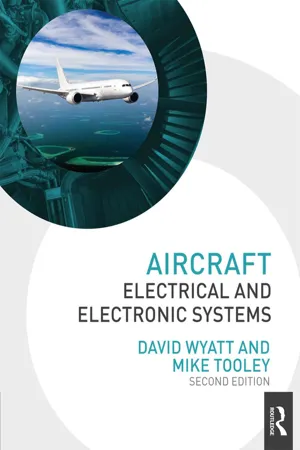
Aircraft Electrical and Electronic Systems
David Wyatt, Mike Tooley
- 420 pages
- English
- ePUB (mobile friendly)
- Available on iOS & Android
Aircraft Electrical and Electronic Systems
David Wyatt, Mike Tooley
About This Book
Introducing the principles of aircraft electrical and electronic systems, this book is written for anyone pursuing a career in aircraft maintenance engineering or a related aerospace engineering discipline, and in particular will be suitable for those studying for licensed aircraft maintenance engineer status. It systematically addresses the relevant sections of modules 11 and 13 of part-66 of the EASA syllabus, and is ideal for anyone studying as part of an EASA and FAR-147 approved course in aerospace engineering.
-
- Delivers the essential principles and knowledge base required by Airframe and Propulsion (A&P) Mechanics for Modules 11 and 13 of the EASA Part-66 syllabus and BTEC National awards in aerospace engineering
-
- Supports Mechanics, Technicians and Engineers studying for a Part-66 qualification
-
- Comprehensive and accessible, with self-test questions, exercises and multiple choice questions to enhance learning for both independent and tutor-assisted study
This second edition has been updated to incorporate: complex notation for the analysis of alternating current (AC) circuits; an introduction to the "all electric aircraft" utilising new battery technologies; updated sensor technology using integrated solid-state technology micro-electrical-mechanical sensors (MEMS); an expanded section on helicopter/rotary wing health usage monitoring systems (HUMS).
Frequently asked questions
Information
Chapter 1 Electrical fundamentals
1.1 Electron theory



